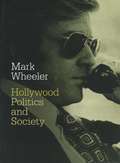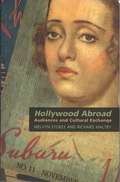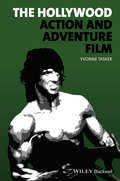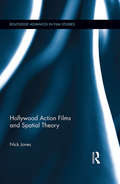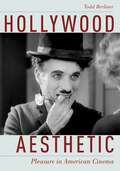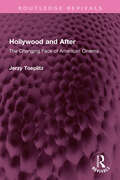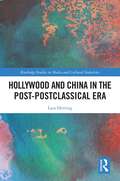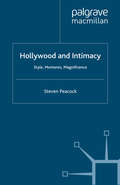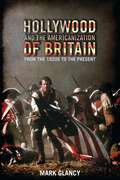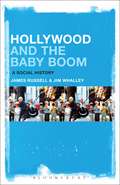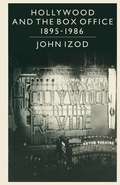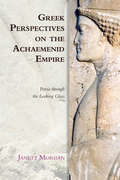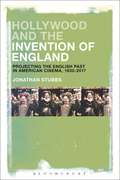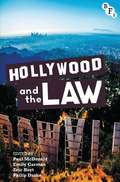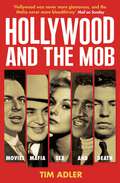- Table View
- List View
Hollywood: Politics and Society
by Mark WheelerAt the beginning of the 21st century, the US film industry had overtaken aeronautics and car industries to become one of the highest exporters of American products. Mark Wheeler's important new book provides both a political history of Hollywood and a reflection on the relationship between cinema and politics in America, from 1900 to the present day. Wheeler considers the interplay between the movies studios, state and national government and cultural policy and legislation, with case studies of the censorship that followed in the wake of the Hays Code 1930 and the investigations of the House Committee of Un-American Activities (HUAC) in the 1950s that led to the notorious blacklisting of alleged or known Communist sympathisers. His history of political constituencies within Hollywood ranges from the conservative right to the liberal and the communist left, from trades unionists to movie moguls. The book concludes with a look at the politics of show business, addressing links between Hollywood and political activism, films such as 'The Candidate' and 'Bulworth' that have themselves engaged with the political process, and considering the irony that despite the fact that Hollywood is perceived as a bastion of liberalism the two most famous actors-turned-politicians have been Ronald Reagan and Arnold Schwarzenegger.
Hollywood Abroad: Audiences and Cultural Exchange
by Melvyn Stokes Richard MaltbyHollywood Abroad is the first book to examine the reception of Hollywood movies by non-American audiences. Although numerous books on film history have analyzed the ways in which American films came to dominate world markets, there has so far been very little published work on how audiences outside the United States have responded to Hollywood-produced films. Hollywood Abroad explores the reception of U.S. films in Britain, France, Belgium, Turkey, Australia, India, Japan, and Central Africa. The book covers topics from the first major penetration of American films into France, Britain, and Australia to the impact of such films as The Best Years of Our Lives to the response of Belgian young people in the age of the multiplex. It demonstrates that the story of the reception of American films overseas is less one of domination than of a complex adoption of Hollywood into various cultures.
Hollywood Abroad: Audiences and Cultural Exchange
by Melvyn Stokes Richard MaltbyHollywood Abroad is the first book to examine the reception of Hollywood movies by non-American audiences. Although numerous books on film history have analyzed the ways in which American films came to dominate world markets, there has so far been very little published work on how audiences outside the United States have responded to Hollywood-produced films. Hollywood Abroad explores the reception of U.S. films in Britain, France, Belgium, Turkey, Australia, India, Japan, and Central Africa. The book covers topics from the first major penetration of American films into France, Britain, and Australia to the impact of such films as The Best Years of Our Lives to the response of Belgian young people in the age of the multiplex. It demonstrates that the story of the reception of American films overseas is less one of domination than of a complex adoption of Hollywood into various cultures.
The Hollywood Action and Adventure Film (New Approaches to Film Genre)
by Yvonne TaskerThe Hollywood Action and Adventure Film presents a comprehensive overview and analysis of the history, myriad themes, and critical approaches to the action and adventure genre in American cinema. Draws on a wide range of examples, spanning the silent spectacles of early cinema to the iconic superheroes of 21st-century action films Features case studies revealing the genre’s diverse roots – from westerns and war films, to crime and espionage movies Explores a rich variety of aesthetic and thematic concerns that have come to define the genre, touching on themes such as the outsider hero, violence and redemption, and adventure as escape from the mundane Integrates discussion of gender, race, ethnicity, and nationality alongside genre history Provides a timely and richly revealing portrait of a powerful cinematic genre that has increasingly come to dominate the American cinematic landscape
The Hollywood Action and Adventure Film (New Approaches to Film Genre)
by Yvonne TaskerThe Hollywood Action and Adventure Film presents a comprehensive overview and analysis of the history, myriad themes, and critical approaches to the action and adventure genre in American cinema. Draws on a wide range of examples, spanning the silent spectacles of early cinema to the iconic superheroes of 21st-century action films Features case studies revealing the genre’s diverse roots – from westerns and war films, to crime and espionage movies Explores a rich variety of aesthetic and thematic concerns that have come to define the genre, touching on themes such as the outsider hero, violence and redemption, and adventure as escape from the mundane Integrates discussion of gender, race, ethnicity, and nationality alongside genre history Provides a timely and richly revealing portrait of a powerful cinematic genre that has increasingly come to dominate the American cinematic landscape
Hollywood Action Films and Spatial Theory (Routledge Advances in Film Studies)
by Nick JonesThis book applies the discourse of the so-called ‘spatial turn’ to popular contemporary cinema, in particular the action sequences of twenty-first century Hollywood productions. Tackling a variety of spatial imaginations (contemporary iconic architecture; globalisation and non-places; phenomenological knowledge of place; consumerist spaces of commodity purchase; cyberspace), the diverse case studies not only detail the range of ways in which action sequences represent the challenge of surviving and acting in contemporary space, but also reveal the consistent qualities of spatial appropriation and spatial manipulation that define the form. Jones argues that action sequences dramatise the restrictions and possibilities of space, offering examples of radical spatial praxis through their depictions of spatial engagement, struggle and eventual transcendence.
Hollywood Action Films and Spatial Theory (Routledge Advances in Film Studies)
by Nick JonesThis book applies the discourse of the so-called ‘spatial turn’ to popular contemporary cinema, in particular the action sequences of twenty-first century Hollywood productions. Tackling a variety of spatial imaginations (contemporary iconic architecture; globalisation and non-places; phenomenological knowledge of place; consumerist spaces of commodity purchase; cyberspace), the diverse case studies not only detail the range of ways in which action sequences represent the challenge of surviving and acting in contemporary space, but also reveal the consistent qualities of spatial appropriation and spatial manipulation that define the form. Jones argues that action sequences dramatise the restrictions and possibilities of space, offering examples of radical spatial praxis through their depictions of spatial engagement, struggle and eventual transcendence.
Hollywood Aesthetic: Pleasure in American Cinema
by Todd BerlinerHollywood makes the most widely successful pleasure-giving artworks the world has ever known. The industry operates under the assumption that pleasurable aesthetic experiences, among huge populations, translate into box office success. With that goal in mind, Hollywood has systematized the delivery of aesthetic pleasure, packaging and selling it on a massive scale. In Hollywood Aesthetic, Todd Berliner accounts for the chief attraction of Hollywood cinema worldwide: its entertainment value. The book examines films such as City Lights and Goodfellas that have earned aesthetic appreciation from both fans and critics. But it also studies some curious outliers, cult films, and celebrated Hollywood experiments, such as The Killing and Starship Troopers. And it demonstrates that even ordinary popular films, from Tarzan and His Mate to Rocky III, as well as action blockbusters, like Die Hard and The Dark Knight, offer aesthetic pleasure to mass audiences. Hollywood Aesthetic explains how Hollywood engages viewers by satisfying their aesthetic desires. Visit the companion website at www.oup.com/us/hollywoodaesthetic
Hollywood Aesthetic: Pleasure in American Cinema
by Todd BerlinerHollywood makes the most widely successful pleasure-giving artworks the world has ever known. The industry operates under the assumption that pleasurable aesthetic experiences, among huge populations, translate into box office success. With that goal in mind, Hollywood has systematized the delivery of aesthetic pleasure, packaging and selling it on a massive scale. In Hollywood Aesthetic, Todd Berliner accounts for the chief attraction of Hollywood cinema worldwide: its entertainment value. The book examines films such as City Lights and Goodfellas that have earned aesthetic appreciation from both fans and critics. But it also studies some curious outliers, cult films, and celebrated Hollywood experiments, such as The Killing and Starship Troopers. And it demonstrates that even ordinary popular films, from Tarzan and His Mate to Rocky III, as well as action blockbusters, like Die Hard and The Dark Knight, offer aesthetic pleasure to mass audiences. Hollywood Aesthetic explains how Hollywood engages viewers by satisfying their aesthetic desires. Visit the companion website at www.oup.com/us/hollywoodaesthetic
Hollywood and After: The Changing Face of American Cinema (Routledge Revivals)
by Jerzy ToeplitzFirst published in English in 1974, Hollywood and After presents contemporary cinema in all its complexity, describing and analyzing the various factors which, in the sixties and seventies, brought so many changes both inside Hollywood and throughout the film industry of the USA. The film industry has been restructured. No longer independent, it now forms only a part, sometimes only a small and secondary part, of large diversified corporations. Formerly rivals, today cinema and television not only coexist, but are forced to cooperate closely in a world of technical developments such as videocassettes, cable TV, and satellite transmissions. The main part of this book is dedicated to artistic and creative questions. A new generation of film makers is making films for a new generation of film goers who are looking for fresh values on the screen. More and more the cinema mirrors the reality of American life: complicated, uneasy, shaken by violent outbursts, charged with a multitude of controversies and conflicts. The rose-tinted American dream, which Hollywood peddled, is a thing of the past. Today the US cinema offers a variety of artistic, political, and social approaches and a wide range of highly individual styles. In the world of social media, OTT platforms, and AI, this book is an important historical reference for scholars and researchers of film studies, film history, and media studies.
Hollywood and After: The Changing Face of American Cinema (Routledge Revivals)
by Jerzy ToeplitzFirst published in English in 1974, Hollywood and After presents contemporary cinema in all its complexity, describing and analyzing the various factors which, in the sixties and seventies, brought so many changes both inside Hollywood and throughout the film industry of the USA. The film industry has been restructured. No longer independent, it now forms only a part, sometimes only a small and secondary part, of large diversified corporations. Formerly rivals, today cinema and television not only coexist, but are forced to cooperate closely in a world of technical developments such as videocassettes, cable TV, and satellite transmissions. The main part of this book is dedicated to artistic and creative questions. A new generation of film makers is making films for a new generation of film goers who are looking for fresh values on the screen. More and more the cinema mirrors the reality of American life: complicated, uneasy, shaken by violent outbursts, charged with a multitude of controversies and conflicts. The rose-tinted American dream, which Hollywood peddled, is a thing of the past. Today the US cinema offers a variety of artistic, political, and social approaches and a wide range of highly individual styles. In the world of social media, OTT platforms, and AI, this book is an important historical reference for scholars and researchers of film studies, film history, and media studies.
Hollywood and China in the Post-postclassical Era (Routledge Studies in Media and Cultural Industries)
by Lara HerringThis book examines the contemporary relationship between Hollywood and China as case studies that help to define a new era in Hollywood film industry, style, and economics, which is termed the ‘post‑postclassical’ period.Centred around a case study of Legendary Entertainment, the analysis shows how the studio adopted and adapted its global strategies in order to gain access to and favour within the Chinese film market, and how issues of censorship and financial performance affected the choices they made. Demonstrating Legendary’s identity as a ‘post‑postclassical’ studio and examining how this plays into its China‑strategy, this book explores how this particular case and the necessary analysis of wider political economic relations offer a periodisation of the contemporary Hollywood‑China relationship.This book will interest students and scholars of media and film studies, as well as academics whose research interests include global cinema, Hollywood, Chinese cinema, transnational cinema, and film industry studies.
Hollywood and China in the Post-postclassical Era (Routledge Studies in Media and Cultural Industries)
by Lara HerringThis book examines the contemporary relationship between Hollywood and China as case studies that help to define a new era in Hollywood film industry, style, and economics, which is termed the ‘post‑postclassical’ period.Centred around a case study of Legendary Entertainment, the analysis shows how the studio adopted and adapted its global strategies in order to gain access to and favour within the Chinese film market, and how issues of censorship and financial performance affected the choices they made. Demonstrating Legendary’s identity as a ‘post‑postclassical’ studio and examining how this plays into its China‑strategy, this book explores how this particular case and the necessary analysis of wider political economic relations offer a periodisation of the contemporary Hollywood‑China relationship.This book will interest students and scholars of media and film studies, as well as academics whose research interests include global cinema, Hollywood, Chinese cinema, transnational cinema, and film industry studies.
Hollywood and Intimacy: Style, Moments, Magnificence
by S. PeacockA critical appreciation of close relationships in the modern American movie, looking in detail at contemporary Hollywood films which explore intimacy and the connections of characters, their surroundings, and points of film style. Peacock's close readings provide a fresh approach to understanding the big American film.
Hollywood and the Americanization of Britain: From the 1920s to the Present (Cinema and Society)
by Mark GlancyFor 100 years, Hollywood has provided both the majority and the most popular of films shown on British screens. For many Britons, Hollywood films are not foreign films. Whether seen in the cinema, on television or the internet, they are regarded as normal screen fare and a part of everyday life.
Hollywood and the Baby Boom: A Social History
by James Russell Jim WhalleyBetween 1946 and 1964 seventy-five million babies were born, dwarfing the generations that preceded and succeeded them. At each stage of its life-cycle, the baby boom's great size has dictated the terms of national policy and public debate. While aspects of this history are well-documented, the relationship between the baby boom and Hollywood has never been explored. And yet, for almost 40 years, baby boomers made up the majority of Hollywood's audience, and since the 1970s, boomers have dominated movie production. Hollywood and the Baby Boom weaves together interviews with leading filmmakers, archival research and the memories of hundreds of ordinary filmgoers to tell the full story of Hollywood's relationship with the boomers for the first time. The authors demonstrate the profound influence of the boomers on the ways that movies were made, seen and understood since the 1950s. The result is a compelling new account that draws upon an unprecedented range of sources, and offers new insights into the history of American movies.
Hollywood and the Baby Boom: A Social History
by James Russell Jim WhalleyBetween 1946 and 1964 seventy-five million babies were born, dwarfing the generations that preceded and succeeded them. At each stage of its life-cycle, the baby boom's great size has dictated the terms of national policy and public debate. While aspects of this history are well-documented, the relationship between the baby boom and Hollywood has never been explored. And yet, for almost 40 years, baby boomers made up the majority of Hollywood's audience, and since the 1970s, boomers have dominated movie production. Hollywood and the Baby Boom weaves together interviews with leading filmmakers, archival research and the memories of hundreds of ordinary filmgoers to tell the full story of Hollywood's relationship with the boomers for the first time. The authors demonstrate the profound influence of the boomers on the ways that movies were made, seen and understood since the 1950s. The result is a compelling new account that draws upon an unprecedented range of sources, and offers new insights into the history of American movies.
Hollywood and the Box Office
by John IzodChanging business circumstances have put pressure on film studios and changed the nature of films they produce. This book examines the reaction of the corporations who have found themselves in danger or have perceived new ways of adding to their profitability, influencing the films they produce.
Hollywood and the Great Depression: American Film, Politics and Society in the 1930s
by Iwan Morgan Philip John DaviesIn the popular imagination, 1930s Hollywood was a dream factory producing escapist movies to distract the American people from the greatest economic crisis in their nation’s history. But while many films of the period conform to this stereotype, there were a significant number that promoted a message, either explicitly or implicitly, in support of the political, social and economic change broadly associated with President Franklin D. Roosevelt’s New Deal programme. At the same time, Hollywood was in the forefront of challenging traditional gender roles, both in terms of movie representations of women and the role of women within the studio system. With case studies of actors like Shirley Temple, Cary Grant and Fred Astaire, as well as a selection of films that reflect politics and society in the Depression decade, this fascinating book examines how the challenges of the Great Depression impacted on Hollywood and how it responded to them.
Hollywood and the Great Depression: American Film, Politics and Society in the 1930s
by Iwan Morgan Philip John DaviesIn the popular imagination, 1930s Hollywood was a dream factory producing escapist movies to distract the American people from the greatest economic crisis in their nation’s history. But while many films of the period conform to this stereotype, there were a significant number that promoted a message, either explicitly or implicitly, in support of the political, social and economic change broadly associated with President Franklin D. Roosevelt’s New Deal programme. At the same time, Hollywood was in the forefront of challenging traditional gender roles, both in terms of movie representations of women and the role of women within the studio system. With case studies of actors like Shirley Temple, Cary Grant and Fred Astaire, as well as a selection of films that reflect politics and society in the Depression decade, this fascinating book examines how the challenges of the Great Depression impacted on Hollywood and how it responded to them.
Hollywood and the Invention of England: Projecting English History In American Cinema, 1930-2015
by Jonathan StubbsDrawing on new archival research into Hollywood production history and detailed analysis of individual films, Hollywood and the Invention of England examines the surprising affinity for the English past in Hollywood cinema. Stubbs asks why Hollywood filmmakers have so frequently drawn on images and narratives depicting English history, and why films of this type have resonated with audiences in America. Beginning with an overview of the cultural interaction between American film and English historical culture, the book proceeds to chart the major filmmaking cycles which characterise Hollywood's engagement with the English past from the 1930s to the present, assessing the value of English-themed films in the American film industry while also placing them in a broader historical context.
Hollywood and the Invention of England (PDF): Projecting the English Past in American Cinema, 1930-2017
by Jonathan StubbsDrawing on new archival research into Hollywood production history and detailed analysis of individual films, Hollywood and the Invention of England examines the surprising affinity for the English past in Hollywood cinema. Stubbs asks why Hollywood filmmakers have so frequently drawn on images and narratives depicting English history, and why films of this type have resonated with audiences in America. Beginning with an overview of the cultural interaction between American film and English historical culture, the book proceeds to chart the major filmmaking cycles which characterise Hollywood's engagement with the English past from the 1930s to the present, assessing the value of English-themed films in the American film industry while also placing them in a broader historical context.
Hollywood and the Law
by Paul Mcdonald, Emily Carman, Eric Hoyt & Philip DrakeSince the earliest days of cinema the law has influenced the conditions in which Hollywood films are made, sold, circulated or presented – from the talent contracts that enable a film to go into production, to the copyright laws that govern its distribution and the censorship laws that may block exhibition. Equally, Hollywood has left its own impression on the American legal system by lobbying to expand the duration of copyright, providing a highly visible stage for contract disputes and representing the legal system on screen. In this comprehensive collection, international experts offer chapters on key topics, including copyright, trademark, piracy, antitrust, censorship, international exhibition, contracts, labour and tax. Drawing on historical and contemporary case studies, Hollywood and the Law provides readers with a wide range of perspectives on how legal frameworks shape the culture and commerce of popular film.
Hollywood and the Mob: Movies, Mafia, Sex and Death
by Tim AdlerFrom its earliest days, the Mafia has sought to make a fast buck from the American film industry. Stories of intimidation, threats and violence mingle with those of glamour and excess. In this stunning story of infamy and ballsy enterprise, Tim Adler tells the secret history of Al Capone, Sam Giancana and John Gotti's attempts to infiltrate the studio lots. However, although they have controlled the moguls and the money, the Mob learned how to be cool from classic films like The Godfather and characters like Tony Soprano, leaving them forever intertwined in both fact and fiction.
Hollywood and the Nazis on the Eve of War: The Case of The Mortal Storm
by Alexis PogorelskinThis book establishes the profound significance of MGM's 1940 film The Mortal Storm, the first major Hollywood production to depict the plight of Jews in Germany before the Holocaust. Based on Phyllis Bottome's best seller, also titled The Mortal Storm, the film was made amidst the bitter debate that occurred between 1938 and 1941 over whether the United States should involve itself in another European war or remain an isolationist country, as Charles Lindbergh among others urged. In 1941, the film triggered the first hostile Congressional investigation of Hollywood where the studios were accused of allegedly propagandizing for war. Lindbergh had secretly urged the Hollywood hearings, inspired by his own growing antisemitism, as his unpublished diary reveals. Hollywood studios, in turn, regarded the growing European crisis with ambivalence. They feared being accused in a film like The Mortal Storm of using the movies to represent the fate of Europe's imperiled Jews. Louis B. Mayer, the head of MGM, insisted the word “Jew” be removed from the film and “non-Aryan” be used instead, hoping to confuse American audiences about the film's real intent. Jimmy Stewart, who starred in the film, took it on the road to urge American aid to Britain, while Lindbergh prepared his own campaign to denounce American Jews for luring the country into war. The book reveals how closely Hollywood and politics were entwined on the eve of war. It also reveals how closely the plight of Europe's Jews and American antisemitism were entwined at the same time.
